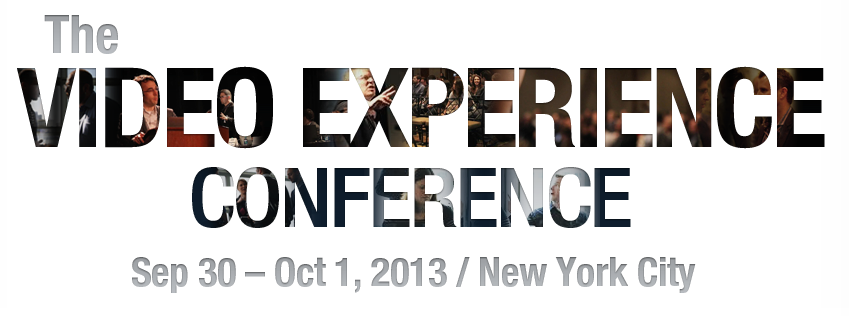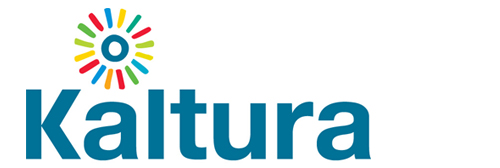I was fortunately able to attend the annual Kaltura Connect conference this year held in New York City at Chelsea Piers, September 30th to October 1st, 2013. Connect brings together thought leaders and technologists for two days to talk about everything video in education, media and corporate. Key trends discussed this year included mobile & HTML5 development, video and MOOCs, webcasting, social video and video marketing.
Of particular value at Connect this year was the ability to network with other institutions already supporting and delivering video in fully online or blended education programs. Presentations were delivered from like-minded colleagues at Columbia, Harvard, Notre Dame, Princeton, Rutgers, and the University of Utah. There was great value in hearing about how these institutions approach video production and dissemination on campus, and most importantly how they support faculty in the production of high quality-high impact educational video.
The hashtag for the event was #kalturaconnect2013 if you would like to review the tweets and social media from the event.
I have compiled my notes below from the speakers I found most meaningful and relevant. These reflections are formed from my notes and thoughts during the presentations and might not be completely representative of what the speakers were saying. I hope to be able to embed the videos of the speakers when they become available from the conference organizers.
Keynotes
The first day was keynoted by Ron Yekutiel the CEO of Kaltura. Ron set the scene for the conference, reminding us that every company is a media company (ECMC) no matter if you are in education, traditional media or the corporate environment. Ron’s analogy of the Connect user community all touching a different part of the same elephant (some of us are touching the trunk, some touching the tail) reminded me that although users are supporting video in a variety of different sectors we do still share quite a bit in common. Video naturally affords us a huge opportunity to connect with our audiences both in real-time and on demand for our own purposes.
Ron spoke at quite a bit about growing the integration and plugins marketplace for Kaltura which includes growing and nurturing the already existing community user groups online and regionally. The Kaltura Exchange is a marketplace for video solutions and services that are complementary to the Kaltura Video Platform. The Exchange includes add-ons, plugins, standalone applications, interoperable services or tools to integrate with other systems. I am excited to hear this as we attempt to embed video across the various systems that we run on campus, including Desire2Learn Mediawiki, and WordPress
Ron gave a brief overview of the various developments going on at Kaltura, of which we would hear more about over the next two days. I reflect on some of the most significant developments later in this post.
The following keynote from Eric Denna, CIO at the University of Utah spoke to me in many ways. Eric challenged us with the question of disruption in higher education; is this sunset on education or a sunrise? A harrowing U.S. statistic raised by Eric was that 50% of higher education graduates are either underemployed or unemployed. Time for change is now and there are number of areas where we can take action.
Eric suggested we rethink the approach we take to designing our courses. The current method that most take when approaching course design:
- Identify learning resources
- Design learning experience
- Identify learning assessment
- Identify learning objective
The obvious problem here is that the selection of learning resources is done first and the experience, assessments and objectives stem from the resources. Most of these resources are coming from publishers so the experiences and assessments are usually included in the instructor resource pack, which is great for time saving, but does not offer much in terms of personalization and differentiation. Eric referenced Michael Hammer’s influential work around process design reminding us of the importance of considering process first then technology/tools second. In Hammer’s research most organizations who considered technology before process were unsuccessful.
Rather start with objective of learning and then move through to sourcing resources to achieve that end.
- Identify learning objective
- Identify learning assessment
- Design learning experience
- Identify learning resources

Regarding video, Eric said that for many students learning would be perfect if it had a play, stop, slow motion, rewind and fast forward button. Video content gives students some control over when, how fast and how they can review material providing a powerful experience and resource to review.
Eric noted five key changes in higher education:
- The unbundling of services
- Elimination of subsidies
- Changing role of the faculty
- Learning analytics and personalization
- Open educational experiences (MOOC’s, OER)
Eric’s thoughts were that these changes constitute a perfect storm for a new beginning. We were reminded that most innovation currently happening around higher education is occurring outside of higher education institutions. With the right attitude we should embrace change and challenge ourselves to operate innovatively in this new landscape.
The third keynote of the morning was from Scott Chambers, SVP Worldwide Media Distribution, Sesame Workshops. Sesame Street has naturally been using educational video for years now with great success. Scott’s key message was that mass media and video have the power to educate. Remarkably children who watched Sesame Street early in their life report higher GPA’s. It was fascinating hearing from Sesame Workshops on how they are approaching online video development and engaging with their audience.
Wendy Collins, VP, Digital Strategy for Infobase Learning presented on Taking Online Video to the Next Level: 10 Tips for a More Engaging and Effective Video Experience. This presentation was filled with great tips for preparing your next video project and thus will be compiled in a separate post specifically on designing video projects.
Mark Ratliff and Ben Johnston from Princeton University shared The Evolution of Video Solutions at Princeton University. Academic technology services at Princeton have a long history of using video in education, going back to QuickTime, Real Media, Flash and Wowza servers. These services were laborious for the centre to operate and maintain and would likely have required the centre do the conversion and uploading of video. With the adoption of Kaltura Princeton is moving towards providing self-service utilities for dealing with videos. Instructors can simply submit video to the MediaSpace application, have the conversion preformed automatically on the servers and then have access to their media. Ben and Mark recognized that the most difficult part for instructors is generally the use of embed codes. I find that once users have worked with embed codes once or twice, they tend to grow comfortable with the concept. However as of now, the challenge of instructors working with embed codes is a small hurdle.
Princeton have designed some neat applications on top of Kaltura using the open API’s. A screenshot generator was designed to allow students to capture stills from a video fight from the Kaltura player. The screenshots are captured and presented in a gallery below the video player. This could be used for a film class to capture and discuss scenes or the framing of a particular shot in a film.
It was noted that instructors at Princeton were frequently looking for somewhere to store and archive their content and Kaltura was seen as one possible solution when it was originally launched. However the real power of Kaltura is in delivering audio/video content on the web, not simply storage, and because of the amount of storage and processing power it takes to convert and deliver this media, the archival of media is not advised. With so much content in the system now, Princeton is developing policy to ensure that content in the system us actually being delivered and not simply stored, which can be determined through analytics. To further deter the storage of media in the system Princeton has considered a charging model for departments wanting to use Kaltura for storage, the model has been built but not yet deployed
Kevin Dowlin, Executive Director, IT and Instructional Services at Rutgers University spoke about Kaltura And The LMS: A Curriculum Transformation. Rutgers has been with Kaltura since 2011 and is run by the Office of Technology and instructional Services (OTIS). Kaltura is integrated with the learning management system (LMS) at Rutgers to simplify the contribution process for instructors and students. This is a model which we considered rolling out at VIU, unfortunately the integration with our LMS just was not ready to be deployed at the time. We do however expect this integration to be in place before the end of the year.
Rutgers goal is to transform the curriculum with the use of powerful and meaningful educational video. The challenge of course is encouraging and inspiring instructors to create great videos. As we know video production is a laborious process and takes significant planning and time to create. Currently instructors are creating lots of talking head style videos with course introductions, short lectures and assignments. Rutgers has also integrated with Camtasia Relay to allow for lecture casting – something for us to look into.
Linda Crowe, Director of Video and Digital Media Marketing for Oracle spoke on Turning Audiences into Customers: Using Videos Effectively Throughout the Marketing Lifecycle. It was fascinating to hear from a corporate entity on how they deal with training their global workforce using video. One of the key messages I took from Linda was the need for each video to have a call to action. A call to action is defined as:
A graphic or text on a website meant to prompt a user to click it and continue down a conversion funnel. It is an essential part of inbound marketing as well as permission marketing in that it actively strives to convert a user into a lead and later into a customer. Wikipedia
If we consider the call to action concept in terms of educational video, we might say that each video we use for educational purposes should also require some action by the viewer. Perhaps an assessment, quiz, discussion post, or reflection must happen as a result of watching the video, thereby ensuring the viewer watches the full video. The call to action in educational video strives to convert a viewer into a successful learner as result of watching the video.
Perry Hewitt, Chief Digital Officer at Harvard University spoke about Video Everywhere! Why It’s A Cornerstone of Effective Digital Strategy. Harvard takes a storytelling approach to their video production. Video us used to tell the stories of the Harvard community for marketing and promotional purposes. Storytelling is seen as a technique that reaches the head and the heart and has been a successful strategy for promoting the university.
A nice idea shared by Harvard was to create a wordle from the video metadata in their instance, and see what story it might tell about the use of video on campus. Will do this at VIU later this year.
To support educational video, Harvard has developed HarvardX, a faculty-led flexible organization comprised of professional staff, fellows, and students. HarvardX collaborates with faculty to:
- develop and distribute online learning objects and tools;
- conduct research on pedagogical and technological innovations and learning outcomes; and
- adapt these innovations to enhance the on-campus experience of Harvard students.
Dr. Nancy Rubin and Melanie Hibbert from Columbia University spoke on Video in Online Learning: Connecting Analytics to Pedagogy. I have been following Nancy on Twitter for some time and enjoy her insight, so it was great to see her present in person! Nancy and Melanie work in the Columbia University School of Continuing Education and help instructors design and deploy online courses and content.
From the sounds of it, online course development at Columbia is a huge production with the process taking about 16 weeks total per course: Design – 4 weeks; Build – 10 weeks; Finish – 2 weeks. The centre is very much hands on in the development process providing an end-to-end solution for faculty. I presume this is to ensure the online courses delivered are of the highest caliber. Nancy commented that there are a growing number of outsourcing options for online course production including publishers and companies dedicated to building online courses. Columbia has decided to keep these processed in house for strategic reasons; a very interesting strategy to ensure their content is unique and contextually relevant.
Some interesting facts about Columbia’s online courses:
- Each online course contains a: social; media; and live events strategy
- Average online course contains 8 videos; videos average about 8 minutes long
- The centre’s employees are sometimes used as actors in videos 🙂
- Videos which get the most viewed are those directly linked to assessment activities – no surprise here
Lessons learned from Columbia online course development include the optimal length of video at 4 minutes 30 seconds. This number was calculated from analytics by averaging the viewer drop off rates. What is interesting about this number is that it is the same regardless of the length of the video; be it 6 minutes or 90 minutes of video users typically only watch 4 minutes 30 seconds.
Another interesting discovery is that students want to keep the video assets used in their course. Much like textbooks or instructor slides, students want to have these materials available as files as they are considered part of the value in attending university. This has not yet come up at VIU, but we may have to find a way to provide the source files to students on request – which could get tricky when copyright material is used under fair use.
Lastly it was found that viewers put more “trust” in videos that are produced at high quality. This is interesting and scary as it indicates that slickly designed but not factually accurate video can influence people. However it does give good motivation to produce high quality videos.
Lastly Ariel Hitron, VP of Products at Kaltura spoke about What’s Coming Up at Kaltura. There are a lot of great new features coming from Kaltura in the next little while. For VIU we will see monumental change in the next few months, as we are currently about two releases behind the most up to date version.
We will implement the latest build, called Hercules, later this year. This release includes the ability to record screencasts from your desktop from VIUTube and create video presentations syncing timed PowerPoint slides to video. The introduction of channels that allow specific users to view video on a channel, this will be useful for courses using video heavily where students need access to the collection of videos via VIUTube. Two new additions to the player include the ability to play the video at double speed, for quick review as well as jump back button, which will allow users to quickly jump pack 5 or 10 seconds in the video.
There is lots on the horizon for the Kaltura platform. The features below are coming in the next iteration of the software and may be deployed here at VIU in the next year or so. Coming within the next 6-12 months from Kaltura:
- A lecture casting software solution – will be watching this development closely as we explore lecture casting on our campus, note that this a software solution only
- In video popup quizzes – quizzes which appear in video at specific points to capture assessments and feedback
- Webcasting; including live to mobile device as well a live to video asset in VIUTube
- Integration with web conferencing software for capturing online meetings (Lync mentioned – Collaborate not mentioned specifically)
- Mediaspace App for iOS – upload from mobile to VIUTube – these apps can also be customized per institution (we can make “VIUTube app” available in iStore)
- Kaltura Application Framework (KAF) expand integration options, widget-ize Mediaspace for embedding where needed.
- This is the technology on which our integration with Desire2Learn will work. Desire2Learn is the first LMS to use the KAF, looking forward to seeing how this works.
- LearningTube – an LMS like environment build atop MediaSpace
- Video combined with curriculum, discussion around video, quizzes
- Very interesting approach, as many LMS are just adding video now, Kaltura can start with video as foundation
- Cross vertical integration, sharing between KMC’s
- This might help with easing access to Collaborate recordings
- MediaSpace integration with Mozilla Popcorn Maker which will allow annotation and remixing web video, audio and images into mashups on top of VIUTube video.
Overall a great experience at Kaltura Connect this year, I managed to connect with so many like-minded colleagues to share ideas about how video is being used in our institution. Next year if we attend we should present on the deployment process at VIU.

